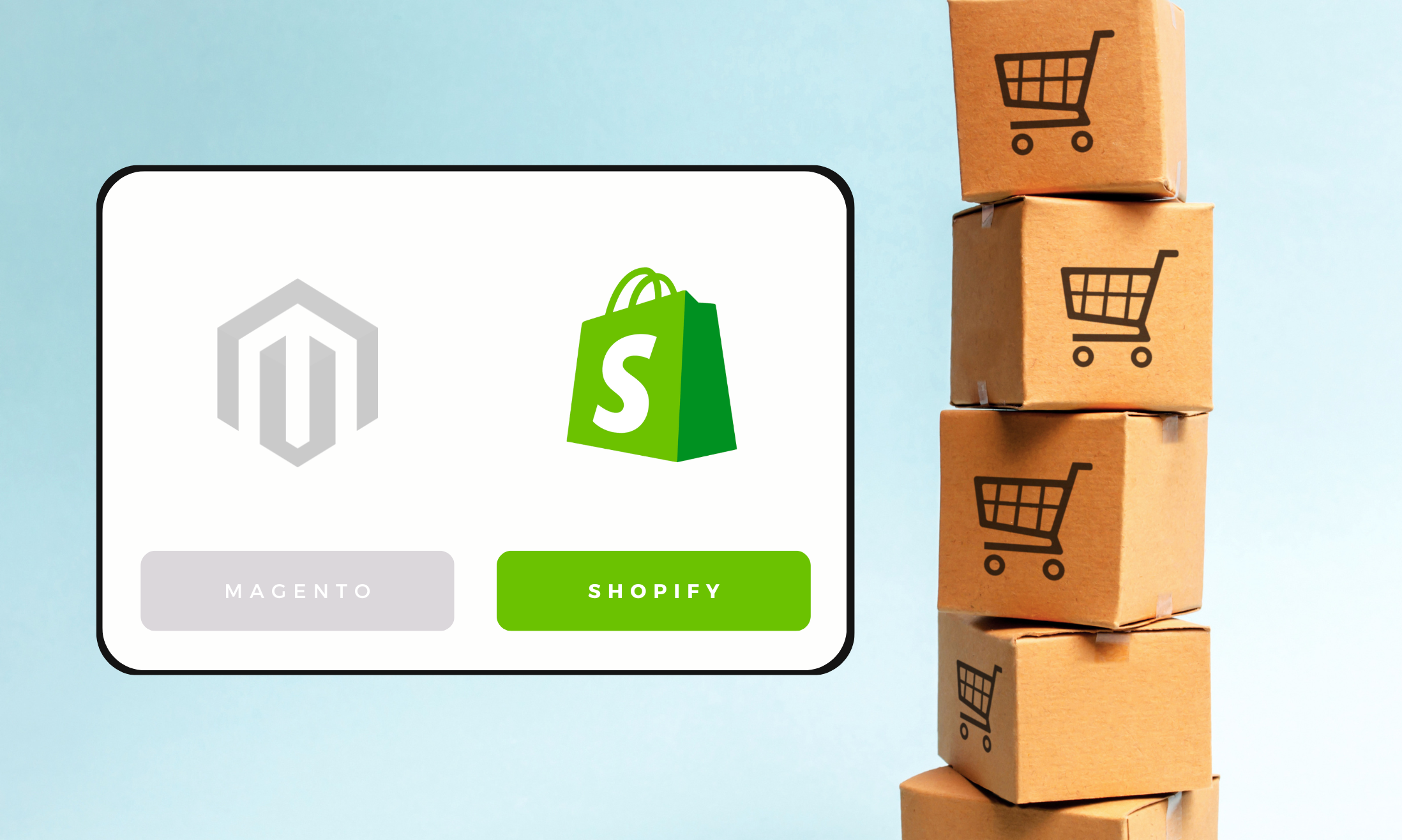The world of e-commerce is a vibrant and competitive landscape, constantly pushing business owners to seek out ecommerce platforms that can propel their growth and success. One such platform that has established its reputation as a powerhouse is Magento (now Adobe Commerce). With its robust features, scalability, and extensive customization options, Magento has been a trusted ally for countless businesses around the globe. However, in the pursuit of innovation and staying ahead of the curve, some businesses are exploring new horizons and considering a Magento to Shopify migration.
The allure of Shopify‘s user-friendly interface, comprehensive app marketplace, and seamless integration possibilities has captured their attention. If you find yourself contemplating this transformative journey, this comprehensive guide is here to assist you every step of the way.
Step 1: Pre-Migration Preparation & Planning
Setting a strong foundation through thorough preparation and planning is key to a successful Magento to Shopify migration. This phase involves critical steps that pave the way for a smooth transition:

Evaluating Your Current Magento Store
Begin by conducting a comprehensive evaluation of your existing Magento store. Assess its performance, functionality, and design aspects. Identify areas that require improvement or customization to ensure a seamless migration to Shopify. This evaluation will help you prioritize tasks and allocate resources effectively.
Identifying Migration Goals and Objectives
Clearly define your migration goals and objectives. Determine what you aim to achieve with the Magento to Shopify migration, whether it’s improving site performance, enhancing user experience, or streamlining management processes. This clarity will guide your decision-making throughout the migration process and ensure that you stay focused on your desired outcomes.
Assessing Budget and Resource Allocation
Understand the financial and human resources required for a successful migration. Evaluate the costs associated with themes, apps, customizations, and any professional services you may need. Consider the availability of in-house expertise or whether you’ll require external assistance. Allocating resources effectively from the beginning will help prevent delays and ensure a smooth migration within your budget.
Choosing the Right Shopify Plan
Explore Shopify’s pricing plans and select the one that best aligns with your business needs and budget. Evaluate the features and limitations of each plan to make an informed decision. Consider factors such as the size of your product catalog, expected traffic volume, and desired functionality.
Exploring Available Migration Options
Research and compare different migration options available for transferring your store data from Magento to Shopify. Shopify offers built-in migration tools, and there are also third-party apps and professional migration services to consider. Assess the pros and cons of each option based on your specific requirements, data complexity, and timeline.
Reviewing Third-Party Integrations and Extensions
Identify any third-party integrations or extensions currently utilized in your Magento store. Determine if they are available in Shopify or if there are suitable alternatives. Consider the impact of these integrations on your store’s functionality and evaluate their compatibility with Shopify’s ecosystem. This review ensures that you maintain essential features and integrations during the migration.
Creating a Backup of Your Magento Store
Before proceeding with the migration, create a comprehensive backup of your Magento store. This includes backing up all the store data, images, configurations, and any customizations you’ve made. Having a reliable backup ensures that you have a safety net in case of any unforeseen issues during the migration. Store this backup in a secure location for easy access when needed.
Creating a Timeline
Break down the project into manageable tasks and establish a realistic timeline. Consider factors such as data transfer, theme setup, customization, and testing. Allocate sufficient time for each task to avoid rushing through critical steps. A well-defined timeline keeps you on track, helps you anticipate potential challenges, and ensures a smooth and organized transition to Shopify.
Step 2: Data Migration
Migrating your data from Magento to Shopify is a crucial step in the migration process. This section outlines the key steps involved in a successful data migration:

Exporting Data from Magento
Exporting your product and unique customer data from Magento to a CSV file is a straightforward process, whether you are using it for manual data manipulation or for migration purposes. Here are the steps to successfully export your data:
- Access the Magento Admin Panel: Log in to your Magento Admin Panel. This is your central hub for managing your store’s data.
- Navigate to the Export Option: From the Admin sidebar, click on ‘System’ then ‘Data Transfer’ and finally ‘Export’. This is the same path you followed when you created a backup of your store.
- Choose your Entity Type: Within the Export Settings, select whether your Entity Type is ‘Products’, ‘Customers Main File’, or ‘Customer Addresses’. This determines the type of data you want to export.
- Select the File Format: Pick the ‘CSV’ option in ‘Export File Format’. This is suitable for manual data import, use with alternative apps like ‘Transporter’, or even to transfer data to other eCommerce platforms such as Shopify.
- Exclude Unwanted Attributes: Check the boxes next to the product attributes you do not want to include in the export process. A message may appear advising you to ensure your cron job is running. Note: Cron is a Magento 2 feature that lets you schedule scripts or commands to automate various tasks in Magento. To configure it, go to ‘Stores’ > ‘Configuration’ > ‘Advanced’ > ‘System’ > ‘Cron (Scheduled Tasks)’.
- Export the Data: Finally, press the ‘Continue’ button at the bottom of the page. This will download all your selected data in CSV file format.
Remember, if you want to export products, customer main files, and customer addresses, you will need to repeat this process for each one. Once completed, you’ll have all your data in a CSV file that can be easily read by other software, making any migration process a breeze.
Make sure you capture all the necessary information:
- Products, Categories, and Attributes: Export your product data, including product price, discount price, attributes, categories, images, and descriptions. This ensures that all your products are transferred accurately to Shopify.
- Customer Information and Order History: Export customer data, including customer profiles, addresses, order history, and any associated data. This allows you to maintain a seamless customer experience during and after the migration.
- SEO Settings and URLs: Export SEO-related settings such as meta tags, URLs, redirects, and canonical tags. Preserving your SEO settings ensures that your Shopify store retains its search engine visibility.
Read more:
- Magento 2 To Shopify Migration: Unlocking Key Benefits
- Magento 1 To Shopify Migration: Motivations, Benefits, Process
Data Mapping and Formatting for Shopify Import
Before importing your data into Shopify, it’s essential to understand Shopify’s data structure and ensure proper mapping and formatting:
- Understanding Shopify’s Data Structure: Familiarize yourself with the data model used by Shopify. This knowledge will help you map your Magento data to the appropriate fields in Shopify and ensure a smooth transition.
- Resolving Discrepancies and Data Inconsistencies: Address any discrepancies or inconsistencies in data formatting between Magento and Shopify. This may involve converting data formats, aligning field names, or reconciling differences in data structure.
Importing Data into Shopify
Once your data is properly prepared, you can proceed with importing it into your Shopify store:
- Using Built-in Shopify Import Tools: Shopify provides native import tools that allow you to import your data directly. Take advantage of these tools to streamline the process.
- Utilizing Third-Party Migration Apps: Explore specialized migration apps available on the Shopify app store. These apps are designed to simplify and automate data transfer, ensuring a seamless migration experience.
- Hiring Migration Services: If you have complex data requirements or lack the technical expertise, consider engaging professional Magento to Shopify migration services. These experts can handle the process for you, ensuring accuracy and efficiency.
Verifying Data Integrity and Accuracy
Thoroughly review and cross-check your data in Shopify to ensure that all information has been accurately migrated. Verify product details, customer profiles, order status, and SEO settings. This step ensures that your new Shopify store reflects your Magento data accurately and maintains a consistent user experience.
Step 3: Design and Theme Migration

To maintain your brand identity and provide a consistent user experience, migrating the design and theme of your ecommerce store is crucial. This section explores different solutions for design migration:
Solution 1: Applying a New Ready-Made Theme for Shopify
- Choose a Shopify theme that aligns with your brand: Browse through Shopify’s theme store or third-party marketplaces to find a theme that reflects your brand identity and desired aesthetics.
- Customize the Shopify theme to match your design preferences: Utilize Shopify’s customization options to personalize the selected theme and ensure it aligns with your previous Magento design elements. Adjust colors, fonts, layouts, and other visual aspects to create a cohesive look.
- Migrate custom Magento design elements: If your Magento store had unique design elements such as logos, banners, or custom layouts, ensure that these are carried over to your new Shopify theme. Customize the theme to incorporate these specific design elements and maintain brand consistency.
Solution 2: Developing a Theme for Shopify Similar to the Current Magento Theme
- Locate the design files of the Magento store: Identify and access the design files used in your Magento store, such as Figma, Sketch, Adobe XD, or InVision. If these files are not available, explore methods to convert your current web design into the preferred design software format.
- Develop a new Shopify theme based on the existing design: Utilize the design files to create a new Shopify theme that closely resembles your current Magento theme. Pay attention to design elements, color schemes, typography, and overall layout to replicate the visual appeal of your existing store.
Solution 3: Creating a New Unique Design for the Shopify Store
- Create a new storefront design using web design software: Utilize your preferred design software to craft a fresh and unique design for your Shopify store. Consider your brand identity, target audience, and desired user experience to create a visually appealing and engaging design.
- Develop a new Shopify theme based on the new design: Convert the newly created design into a fully functional Shopify theme. Ensure that all design elements, including layouts, typography, images, and interactive elements, are appropriately implemented. Conduct thorough testing to guarantee a seamless user experience.
Regardless of the solution you choose, it’s essential to maintain consistency in branding, user interface, and overall user experience. Regularly review and optimize your design elements to align with your business goals and keep up with evolving design trends.
Step 4: Custom Development and Advanced Features
As you migrate from Magento to Shopify, it’s crucial to assess the custom functionality and features your Magento store currently has and explore how they can be replicated or replaced in Shopify.

Identifying custom functionality and features from Magento
List down the custom features and functionality you currently have in Magento, such as custom product types, advanced search options, or complex pricing structures.
Assessing Shopify’s capabilities and available apps
Explore Shopify’s built-in features and the extensive range of apps available in the Shopify app store to identify alternatives or solutions that can replicate or enhance the existing custom functionality.
Custom development considerations and options
Determine whether any custom development work is required to build or modify features specific to your business needs. Assess the scope, costs, and technical expertise required for such development.
Working with Shopify experts or developers, if needed
If your migration requires complex customization or development work, consider collaborating with Shopify experts or developers to ensure a seamless implementation.
Step 5: Content Migration
To ensure a seamless transition, migrating your content, including static website pages, blog posts, articles, images, and multimedia content, is crucial.

Migrating Static Website Pages
- Exporting static website pages: Export your static website pages from Magento, including all relevant content, formatting, and structure.
- Importing pages to Shopify: Utilize Shopify’s import tools or third-party migration apps to import your static website pages into the new Shopify store. Pay attention to preserving the original formatting and structure to maintain consistency.
Transferring Blog Posts and Articles
- Exporting blog posts and articles: Export your blog posts and articles from Magento, ensuring that all accompanying data, such as categories, tags, and comments, are included.
- Importing to Shopify’s blogging platform: Utilize Shopify’s built-in blogging platform to import your blog posts and articles. Ensure that the formatting, images, and embedded media are retained. Alternatively, you can explore third-party apps specifically designed for blog migration.
Importing Images and Multimedia Content
- Exporting image and multimedia files: Export all image files and multimedia content used in your Magento store, ensuring you maintain the original file names and folder structure.
- Importing to Shopify: Transfer the image files and multimedia content to Shopify’s media library. Ensure that the links and references to these files in your content are updated to reflect the new URLs in the Shopify store.
- Linking and displaying multimedia content: Update the relevant content (e.g., pages, blog posts) to link and display the multimedia content correctly. Verify that images are properly displayed, videos play correctly, and other multimedia elements function as intended.
During the content migration phase, regularly review and optimize your content for SEO and user experience. Pay attention to broken links, missing images, and any formatting inconsistencies. Additionally, consider updating your content to align with the new design and branding of your Shopify store.
Step 6: SEO Considerations
Preserving your search engine rankings and optimizing your new Shopify store for SEO is essential to maintain organic traffic. Follow these key SEO considerations:

Setting up 301 Redirects for Magento URLs
Implement 301 redirects to ensure that your old Magento URLs automatically redirect to the corresponding pages on your new Shopify store. This preserves search engine rankings and prevents broken links, providing a seamless user experience.
Updating Metadata and On-Page SEO Elements
Review and update metadata elements to align with your new Shopify store and optimize for search engines:
- Page Titles: Craft unique and descriptive page titles using relevant keywords to accurately represent the content of each page.
- Meta Descriptions: Write compelling meta descriptions that summarize the page content and entice users to click through from search engine results.
- Headings: Structure your content with proper heading tags (H1, H2, etc.) to provide a clear hierarchy and improve readability for both users and search engines.
- Alt Tags: Optimize alt tags for images by using descriptive and keyword-rich descriptions to improve accessibility and provide context to search engines.
Configuring Canonical Tags and Structured Data
Ensure the proper implementation of canonical tags to avoid duplicate content issues. Additionally, optimize structured data markup to enhance search engine visibility and improve click-through rates:
- Canonical Tags: Use canonical tags to indicate the preferred version of duplicate or similar content, helping search engines understand the original source.
- Structured Data Markup: Implement structured data markup (e.g., schema.org) to provide search engines with additional information about your products, reviews, events, and other relevant content, enhancing search engine visibility and rich snippets.
Submitting an Updated Sitemap to Search Engines
Generate an updated XML sitemap for your new Shopify store, including all relevant URLs, and submit it to search engines. This ensures that search engines can properly index your site and discover all relevant pages.
Adding Useful Shopify SEO Apps
Explore the app store for Shopify SEO apps that can further enhance your store’s search engine optimization. These apps can provide valuable insights, automate certain SEO tasks, and offer advanced features to improve your store’s visibility and rankings.
Step 7: Payment Gateways and Transactions
Ensuring a seamless and secure payment process is essential for customer satisfaction and business success. In this section, we will delve into managing payment gateways and transactions during the migration process to Shopify.

Evaluating Payment Gateway Options in Shopify
Start by assessing the available payment gateway options in Shopify. Consider factors such as compatibility with your business model, target market, and customer preferences.
Shopify offers a range of payment gateways, including popular choices like PayPal, Stripe, Authorize.net, and many more. Evaluate the features, transaction fees, and integration capabilities of each gateway to make an informed decision that aligns with your business goals and requirements.
Configuring and Integrating Payment Gateways
Once you have selected the payment gateways that best suit your needs, it’s time to set them up and configure them in your new Shopify store. Shopify provides user-friendly interfaces to simplify the configuration process.
Follow the instructions provided by your chosen payment gateways to seamlessly integrate them into your store. Configure settings such as currency, accepted payment methods, and transaction settings to ensure a smooth payment experience for your customers.
Testing Payment Transactions and Ensuring Secure Checkout
Thoroughly test the payment transactions within your Shopify store to ensure they are functioning correctly and securely. Conduct test purchases using different payment methods and scenarios, such as successful transactions, declined payments, and refunds.
Step 8: Shipping and Fulfillment
Efficient shipping and order fulfillment processes play a crucial role in delivering a positive customer experience. In this section, we will explore the necessary steps to set up shipping and fulfillment in your new Shopify store, ensuring smooth operations and timely delivery.

Understanding Shipping Options in Shopify
Before diving into the setup process, it’s important to familiarize yourself with Shopify’s built-in shipping options and settings. Take the time to explore the various features available, such as shipping rates, carrier integrations, and fulfillment services. Understanding these options will allow you to make informed decisions and tailor your shipping strategy to meet your specific business needs.
Configuring Shipping Rates and Methods
To provide accurate shipping costs to your customers, configure shipping rates based on factors such as product dimensions, weight, and destination. Shopify offers flexible options to set up shipping rates, including flat rates, weight-based rates, and location-based rates. Carefully evaluate your shipping requirements and choose the most suitable approach for your business.
Integrating with Shipping Carriers and Fulfillment Services
Streamlining your shipping and fulfillment processes is made easier through Shopify’s integrations with popular shipping carriers and fulfillment services. Explore the available carrier integrations and choose the ones that align with your business needs.
Step 9: Testing and Quality Assurance
Thorough testing and quality assurance are critical steps before launching your new Shopify store. This section highlights the key areas to focus on during the testing phase to ensure a smooth and error-free customer experience.

Conducting Comprehensive Functionality Testing
It is vital to thoroughly test all the essential functionalities of your new Shopify store. This includes meticulously checking the navigation, product browsing, cart and checkout process, user registration, and account management. Put yourself in the shoes of your customers and go through each step to ensure everything is functioning as expected.
Testing Responsiveness and Compatibility
In today’s mobile-centric world, it is essential to test the responsiveness and compatibility of your Shopify store across various devices and browsers. Test your website on different smartphones, tablets, and desktop screens to ensure it displays correctly and functions seamlessly on all devices. Check that the layout adjusts appropriately, images are optimized, and all interactive elements are easily accessible.
Testing Performance and Load Capacity
Website performance and load capacity are crucial factors that can impact user experience and conversion rates. Test your Shopify store’s performance by conducting load testing under different traffic conditions to identify any bottlenecks or slowdowns. Measure page load times, server response times, and overall website performance metrics.
Conducting Cross-Browser Compatibility Testing
With a diverse range of web browsers available, it’s essential to conduct cross-browser compatibility testing to ensure a consistent experience for all users. Test your Shopify store on popular web browsers such as Chrome, Firefox, Safari, and Internet Explorer to ensure that all functionalities, layouts, and design elements are displayed correctly across different platforms.
Magento To Shopify Migration Common Issues
Despite careful planning, you may encounter challenges or roadblocks during the Magento to Shopify migration. This section provides guidance on addressing common migration issues:

Addressing Common Challenges and Roadblocks During Migration
It’s important to be prepared for potential challenges that may arise. Some common issues include data inconsistencies, theme compatibility, and functionality gaps.
To address these challenges proactively, it’s crucial to identify them early on and develop strategies to overcome them. This could involve conducting thorough testing, working closely with your development team, or seeking advice from Magento to Shopify migration experts.
Troubleshooting Data Mapping and Formatting Issues
Data mapping and formatting issues can occur when transferring data from Magento to Shopify. If you encounter any discrepancies or inconsistencies in your data, refer back to the data mapping and formatting section earlier in this guide.
Review the steps and guidelines provided to ensure that your data is correctly mapped and formatted for a successful Magento to Shopify migration. If needed, consult with your development team or migration experts to resolve any lingering issues.
Handling Technical Glitches and Compatibility Concerns
Technical glitches and compatibility concerns may arise during the process of migration. These could be related to theme compatibility, custom functionalities, or third-party integrations. In such cases, it’s recommended to reach out to Shopify’s customer service for assistance. They have a dedicated support team that can provide guidance and solutions to resolve technical issues.
Additionally, the Shopify community forums are a valuable resource where you can seek advice from experienced users and developers who may have encountered similar challenges.
Getting Help from Professionals
In some cases, the complexities of the project may require the expertise of professional ecommerce platform migration service providers. These specialized agencies have extensive experience in handling Magento to Shopify migrations and can provide end-to-end support. If you find yourself overwhelmed or require additional assistance, engaging a professional Magento to Shopify migration service provider can save you time and effort while ensuring a successful transformation.
Looking for Magento to Shopify migration service?
Magento to Shopify migration can be a complex process, but with proper planning, preparation, and execution, it can be a seamless transition. By following the steps outlined in this comprehensive guide, you’ll be well-equipped to migrate your data, design, and functionality to Shopify while minimizing disruptions and maximizing the potential of your new online store.
Remember to thoroughly test and review each stage of the migration process to ensure a smooth launch, and don’t hesitate to seek professional assistance if needed.

If you’re looking for a reliable and affordable Magento to Shopify migration service, consider partnering with Tigren. With our expertise in e-commerce migration and a deep understanding of both Magento and Shopify, we can help you navigate the complexities of the project while ensuring a seamless transition.
Our team of experienced professionals will guide you every step of the way, ensuring that your data is securely transferred, your design is faithfully recreated, and your store is optimized for success on the Shopify platform.
Good luck with your Magento to Shopify migration journey, and may your new store bring you continued success in the world of e-commerce!

